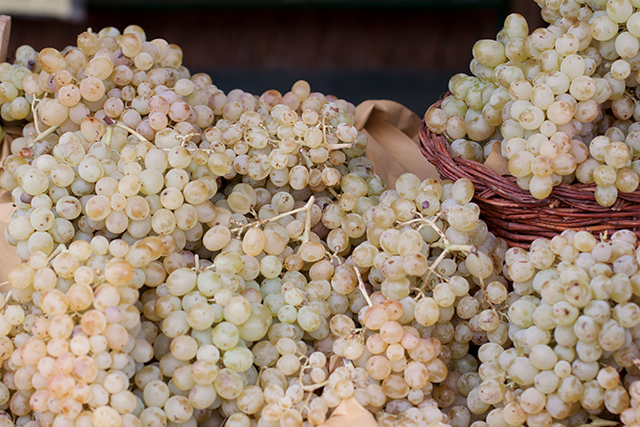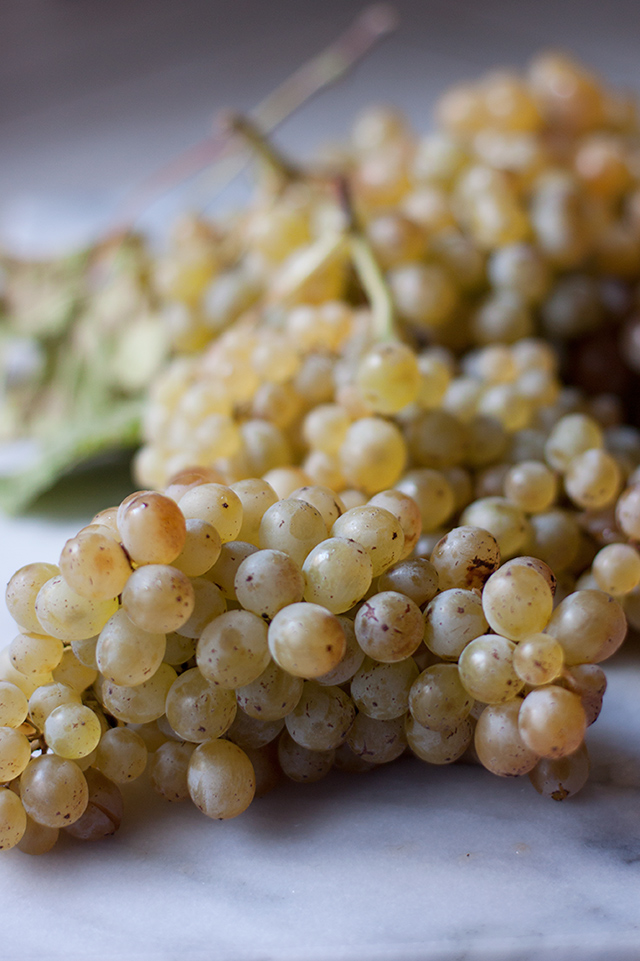I first found crates full of these white grapes with a scribbled sign stating “local grapes, 1 euro a kilo” at the fruit and vegetable shop down the road. Cheap grapes are a sign that we are already well into the vendemmia (grape harvest) season. Being married to a sommelier I probably should have known right away what kind of grapes they were, after all, this part of Tuscany is the only place that grows these. But it took me another trip to the shop to buy another kilo of these pale, dusty, copper-tinged grapes to realise they were Ansonica grapes.


It’s a grape native to Sicily (they use it to make Marsala in western Sicily) that made it’s way to the southern Tuscan coast via some island hopping — first to Sardinia then to Elba Island and then to Giglio Island and Argentario. Here it’s made into a savoury, golden-hued white wine called Ansonica Costa dell’Argentario DOC.
Eaten fresh the grapes are very sweet but have a bit of a tannic aftertaste (particularly the greenish grapes), so I made jam. It’s a fragrant, well-set jam that turns an unexpectedly intense, rusty colour as it cooks and is lovely with cheese, especially something goaty and fresh or bitey and blue — just perfect are these beautiful cheeses I brought back from from a nearby organic farm, La Parrina, possibly the most picturesque place to do food shopping.


I tried this recipe several times and in two ways — the first like a regular jam but with a small amount of sugar. The second way, without any sugar at all. Just grapes. The first way is quicker and you can achieve a slightly softer set. The second way, despite being sugarless, is actually sweeter! And much more intense. You also end up with a rather small amount of jam afterwards. And this is all simply because this way is a super-concentrate of the grape juice. I was determined to try to make it work because I had made scrucchiata, a traditional red grape jam from Abruzzo, before and it’s beautiful and so easy. But I’ll be honest, the white grape version is slightly more work this way (you have to keep an eagle eye on it) and you get a bit less jam in the end as the skins are strained out. But you are left with a bright, jewel-like, fragrant, firm-set jam that is just as lovely on a cheese board as on toast.
Cooking the juice down is the tricky bit and reminded me a little of melting sugar down into caramel – you don’t want to stray too far away from the pot because while your back is turned it will misbehave and go too far. During one of the tests I did just this and ended up with a jam so solid that I could barely even cut it!

Ansonica grape jam — first method
Makes two small jars of jam
- 1 kilo of ansonica (or other white grape) grapes
- 100 grams of white sugar
Rinse the grape bunches and pull most of the grapes off the bunch and off their stems (if some remain you can always strain out later). Without patting them dry, place in a large, heavy-bottomed pot and place over low heat. As they heat they will begin to release their own juice and will soon be covered in liquid but before this happens you will need to keep an eye on the pot and stir regularly to make sure the grapes at the very bottom don’t stay there too long and burn. Once the liquid is released, you can leave them and let them simmer gently for about 20 minutes, or until they are all soft.
Pour the grapes and their juice into a fine-meshed sieve set over a large bowl. Squash the grapes in the sieve to release the juice/flesh — I do this with a wooden spoon — and make your way through all the grapes this way to separate the juice from the skins and seeds. It can be a little laborious, but a food mill could help you (as long as it doesn’t squash the seeds too – this would create bitterness), and doing it in a few stages is easier.
Pour the juice back into the pot, add the sugar and bring to a rolling boil. Cook until the colour of the juice turns a shiny, copper tone – this may be as little as 10-15 minutes for a soft set. Test the jam set by having a saucer in the freezer and placing a teaspoon or so of the cooking jam onto the cold saucer. Turn the saucer around to cool down the jam and see how it behaves – if it’s thick, sliding slowly and wrinkles when you poke it, it is perfect.
Remove from heat and pour carefully into clean jam jars. Seal and let cool.
Anonsica grape jam — second (sugarfree) method
Makes 1 small jar of jam
- 1 kilo of ansonica (or other white grape) grapes
Follow the instructions as above except do not add sugar. Place the juice back into the pot and bring to a rolling boil. Cook down until the jam is set — this takes longer than the sugar version. The best guide to understand whether the jam is ready is the colour. When it goes back in the pot, it’s an opaque, pastel peach with a hint of green. Rather like cloudy apple juice. Then as it cooks you’ll watch it turn into the colour of a rusty sunset. It will slowly get darker but you want it to hover around this rosy-rusty, almost honey-toned shade. When it gets darker, heading towards mahogany, it’s gone too far. Continue the saucer test as described above to check when the jam is ready.
Serve this fragrant, intense jam as you would any regular jam — but I love this on a cheese board. We eat it for breakfast on toast with ricotta too.




Comments
I was looking forward to this recipe Emiko and now Nico keeps asking me when he is going to try this jam. Beautifully written and presented as always. Thank you again for taking the time to show us Monte Argentario and beyond, we had such a wonderful time this weekend (so off topic but had to be said).
It was so great to have you guys here and show you around! Love jam-lovers 🙂
La Parrina ! its a must to visit it ! it’s one of the first place a visit as soon as I drop my suitcase when I arrive 🙂
Nice written recipe. Today I ,ll try to make with The grapes from my garden ..Seeing on your activity in writing the cook books , I want to write the cook book of my region ,describing the wedding parties of my grandparents to my own.I even bought some books how to write recipe from Amazon I,m everyday visitor of your site.
Thank you! A great book that I would recommend for recipe writing too (if you don’t already have it) is the Recipe Writer’s Handbook. Good luck!
I’m the founder/moderator for Punk Domestics (www.punkdomestics.com), a community site for those of use obsessed with, er, interested in DIY food. It’s sort of like Tastespotting, but specific to the niche. I’d love for you to submit this to the site. Good stuff!